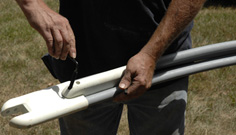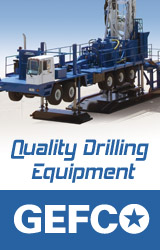Exploring the Advantages of PEXa-based Geothermal Systems
 With a notable increase in commercial and residential geothermal system installations throughout North America, those from across the building community have begun to closely assess the variety of system options available today. This includes the evaluation of PEXa (crosslinked polyethylene) ground loops and U-bends as an alternative to traditionally used HDPE (high-density polyethylene) piping systems.
With a notable increase in commercial and residential geothermal system installations throughout North America, those from across the building community have begun to closely assess the variety of system options available today. This includes the evaluation of PEXa (crosslinked polyethylene) ground loops and U-bends as an alternative to traditionally used HDPE (high-density polyethylene) piping systems.
HDPE is a product that has been around a long time in North America, and it’s more familiar among geothermal installers. As HDPE is a commodity pipe that’s well entrenched in the geothermal industry and readily available in the construction product supply chain, many installers see it as a comfortable choice.
However, PEXa is a high-performance thermoelastic polymer material that has been used for decades in residential and commercial HVAC and plumbing pipe applications, as well as for municipal and industrial wastewater management. The permanent crosslinking process bonds HDPE molecule chains together in a way that improves the properties of the PE, particularly in respect to high-temperature and stress cracking resistance, flexibility, and creep. Therefore, the robust characteristics of PEXa fit well with geothermal ground-loop heat exchange applications for a variety of reasons.
Tough on the jobsite
Geothermal applications rely heavily on the performance of the well-field pipe, particularly during initial installation. Pipe can be exposed to extreme temperature changes, rough terrain, and generally severe treatment, requiring it to withstand installation in a manner that ensures its performance integrity. The unusually durable, yet flexible nature of PEXa polymer translates to a piping system that can withstand the repeated creasing, scratching, notching, and potential for puncturing typical on a jobsite, without any type of permanent damage. PEXa pipe has also exhibited resistance to tension cracking when subjected to point loads, and has exhibited no long-term crack propagation on the job.
PEXa pipe offers additional confirmed performance attributes, including resistance to thermal aging (or brittle fracture) in long-term inner pressure tests up to 203° F (95° C), and higher chemical stability in comparison to its HDPE counterpart.
Streamlining installation
As pressure to control jobsite labor costs remains one of the most crucial concerns in any construction project. PEXa pipe offers additional advantages in respect to streamlining the installation process. Its flexible nature enhances installation parameters by enabling a minimum bend radius as tight as five times the pipe’s outer diameter, or OD (and three times the OD with heat); thereby, eliminating the need for fittings at the top of a vertical loop and making it easier to install pipe in tighter spaces. Also, the elemental resistance and overall performance properties of PEXa make it possible to eliminate the use of a sand bed and install the pipe directly in the soil, translating into significant cost savings in material and labor. PEXa pipe can also be installed during a wide range of weather conditions, including in temperatures as low as 5° F (-15° C).
The nature of a PEXa pipe system’s unique cold expansion compression-sleeve fitting solution offers several additional benefits in respect to streamlining installation, including requiring no heat or electricity onsite. Also, these fittings eliminate the need for labor that’s specially trained in butt and socket fusing techniques, which are typically used in HDPE pipe installations. Fusion-welded pipes additionally can vary in performance, depending on the quality of the labor, whereas compression-sleeve fittings perform with consistent reliability. Like their fusion-welded counterparts, compression-sleeve fittings can also be buried underground or in concrete, and provide a long-term strength greater than the pipe itself.
The U-bend advantage
A U-bend, which is the 180° bend of pipe length at the bottom of a vertical loop, represents a crucial component of the geothermal system. PEXa U-bends can be considered particularly desirable, as they are constructed in a joint-free manner in which the pipe itself is pre-bent and cast into a solid resin shell. The result is a highly reliable U-bend with no connecting point flow obstructions, and no chance of failure in the borehole due to a fittings malfunction.
Offering an additional system performance advantage, PEXa U-bends can also be coupled together as double U-bends, promoting the potential for 15% to 20% more heat exchange in each borehole. As a result, drilling costs can be significantly reduced. In addition, when each loop is connected separately to a central manifold, a double U-bend arrangement provides an extra level of security through virtue of redundancy as, if one loop is damaged, the entire borehole is not lost.
Integration attributes
While able to be integrated with either water-to-air or water-to-water systems, a PEXa-based ground loop’s performance is optimized when combined with a centralized water-to-water geothermal heat pump system. In this type of configuration, energy is transferred from the external loop field to the internal HVAC fluid stream that then heats and cools the building. This is achieved as the conditioned water flows through a system of radiant heating and cooling pipes (also typically composed of PEX), embedded in the walls, floors, and/or ceilings.
A radiant system can more efficiently distribute heat in a building via the use of water versus air, and, therefore, requires more moderate overall operating temperatures (on average, 115° F/46° C in the heating mode, and 60° F/15° C in the cooling mode). This translates to notably less energy demand on the actual geothermal heat pump when a radiant system is used.
To illustrate the performance efficiencies of a radiant (water-to-water) versus a forced air (water-to-air) geothermal system configuration, a nominal four-ton (45,700 Btu/hr) water-to-air heat pump with a ECM blower motor that requires 677 watts at full speed has a delivery efficiency of 67.5 Btu/hr per watt. In comparison, a properly designed radiant (or hydronic) system can deliver the same amount of heat using a single 40-watt ECM circulator instead, with a resulting 1,143 Btu/hr per watt distribution efficiency. A hydronic system can operate at less than six percent the wattage of a forced air system’s ECM blower, notably reducing energy consumption and cost.
Geothermal in action
It’s true that many installers are more familiar with and more comfortable using HDPE piping systems. HDPE offers a simplistic manufacturing process and is cost-effective. The PEX alternative is fairly new on the North American front, but is also proving quite promising and efficient.
In the recent construction of its University Commons student center, Philadelphia-area Arcadia University was encouraged to switch its geothermal ground-loop piping specifications from HDPE to PEXa. In all, forty-two 396-foot wells have been drilled to support the system, which is in its final stages of installation. Using a PEXa-based system for the first time, geothermal installing contractor Jake Kocher of Kocher Geothermal Services has noted some key advantages.
According to Kocher, “The PEX pipe is definitely more flexible than HDPE, and the fittings are very quick to make. Also, being able to isolate individual boreholes on the manifold is a great advantage. With HDPE we were connecting five or eight boreholes together, either in a circuit or in parallel. But with the way that the PEX system is designed, we have a lot more control in the initial balancing of the system, and will also have more control over its operation.”
Author Mike Dietrich is the business team manager for building technology at REHAU.
REHAU
www.rehau.com
Author: Mike Dietrich
Volume: September/October 2011











